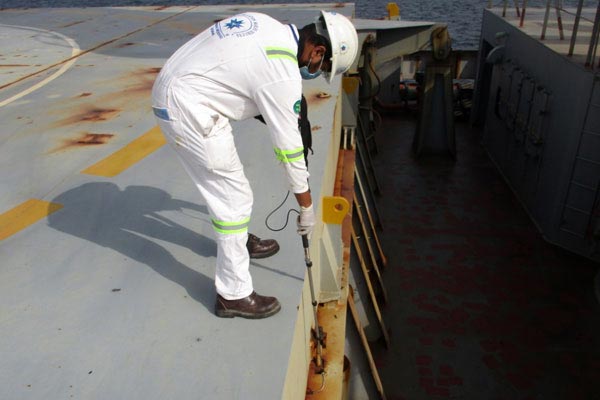


We, Constellation Marine Services LLC as independent ship and marine surveyors, often get instructions from our principals for Ultrasonic Leak Detection test to be carry out on Cargo Hold hatch covers for the watertight integrity. Recently we got a nomination from one of our clients to carry out ULD testing of hatch covers on board a Bulk carrier and report on the watertight integrity of cargo holds. Our Master Mariner/Naval Architect upon receiving instruction for the survey contacted the concerned agents & arranged to attend a survey on board the subject vessel at Abu Dhabi port in relation to ULD inspection.
Constellation Engineer Surveyors’s Attendance
on Board the Vessel.
Upon receiving the notice from the agent our attending Master
Mariner/ surveyor boarded the vessel. Vessel was in ballast
condition. Upon boarding the vessel, he met the Master/Chief
officer & explained our scope of the attendance.
Vessel has 5 cargo holds of following capacity
Grain (cbm) Bale (cbm)
No.1: 12.601,90 11.940,00
No.2: 14.659,30 14.007,40
No.3: 13.498,10 12.806,50
No.4: 14.239,30 13.597,60
No.5: 14.451,80 14.016,60
Total: 69.450,40 66.368,10
Principle: Ultrasonic waves produced by the transmitter in the enclosed space will leak through smallest apertures. Leaking of sound will be detected by receiver or detector. Extent of leakage will depend on decimal value.
Prior to testing we calibrated the equipment with transmitter & receiver. One of the crew placed the transmitter at center of the cargo hold. Receiver & transmitter has been remotely connected. Upon connecting the transmitter to receiver, we have taken the open-hatch value of the Hold (Approx. 44 dB). After closing the hold, we inspected the hatch cover on all sides with the use of telescopic extension & neck band headphones. Leaking places were also witnessed by the Chief Officer using headphones. At 4 places per hold we found leak. We assumed it is due to non-tightening of cleats. So, we requested chief officer to tighten all the cleats of all hatch Covers to inspect once again to ensure the leakage. Again, we inspected all cargo holds so this time the leakages were reduced however at 2 places still we noted the leakage in one of the hold. We found it is due to the damage of rubber gasket. We suggested the chief officer to replace the damaged gasket & inform us to recheck the failed cargo hatch.